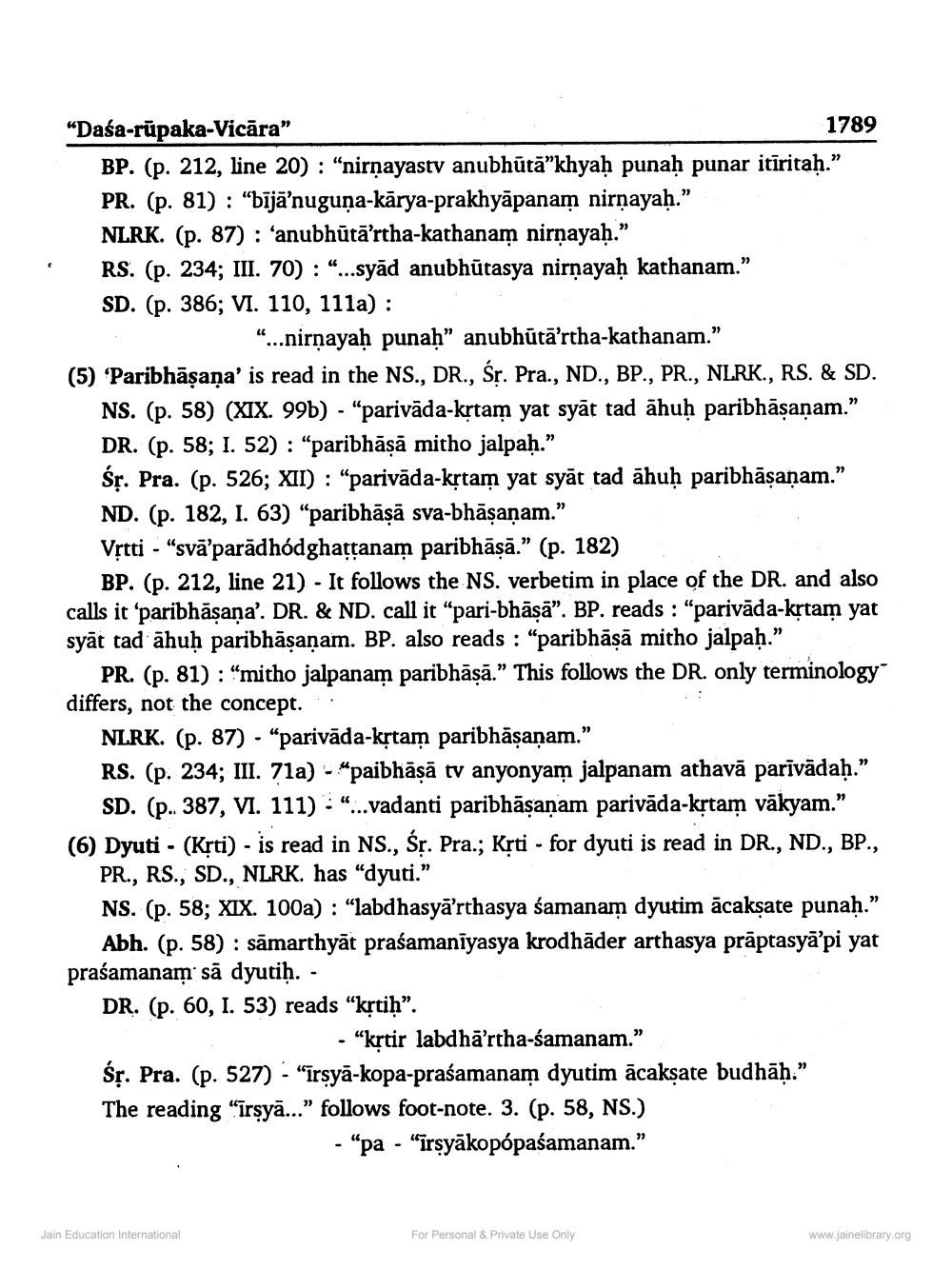________________
"Daśa-rūpaka-Vicāra"
1789 BP. (p. 212, line 20): “nirņayasty anubhūtā”khyaḥ punaḥ punar itīritah.” PR. (p. 81) : “bījā'nuguņa-kārya-prakhyāpanam nirnayah." NLRK. (p. 87): 'anubhūtā’rtha-kathanam nirnayah." RS. (p. 234; III. 70) : “...syād anubhūtasya nirnayaḥ kathanam.” SD. (p. 386; VI. 110, 111a) :
“...nirņayaḥ punaḥ” anubhūtā’rtha-kathanam.” (5) 'Paribhāṣaṇa' is read in the NS., DR., Śr. Pra., ND., BP., PR., NLRK., RS. & SD.
NS. (p. 58) (XIX. 99b) - “parivāda-krtam yat syāt tad āhuḥ paribhāṣaṇam.” DR. (p. 58; I. 52) : “paribhāṣā mitho jalpaḥ.” Śr. Pra. (p. 526; XII) : “parivāda-krtam yat syāt tad āhuḥ paribhāsaņam.” ND. (p. 182, I. 63) “paribhāsā sva-bhāṣaṇam.” Vịtti - "svā’parādhódghattanam paribhāṣā.” (p. 182)
BP. (p. 212, line 21) - It follows the NS. verbetim in place of the DR. and also calls it ‘paribhāsaņa'. DR. & ND. call it “pari-bhāṣā”. BP. reads : “parivāda-kặtam yat syāt tad āhuḥ paribhāsaņam. BP. also reads : “paribhāṣā mitho jalpaḥ."
PR. (p. 81) : “mitho jalpanam paribhāsā.” This follows the DR. only terminology differs, not the concept...
NLRK. (p. 87) - “parivāda-kstam paribhāṣaṇam." RS. (p. 234; III. 71a) - paibhāṣā tv anyonyam jalpanam athavā parivādah.”
SD. (p.. 387, VI. 111) : “...vadanti paribhāṣaṇam parivāda-krtam vākyam.” (6) Dyuti - (Krti) - is read in NS., Śr. Pra.; Kști - for dyuti is read in DR., ND., BP.,
PR., RS., SD., NLRK. has “dyuti.” NS. (p. 58; XIX. 100a) : “labdhasyā’rthasya śamanam dyutim acakşate punaḥ.”
Abh. (p. 58): sāmarthyāt praśamanīyasya krodhāder arthasya prāptasyā’pi yat praśamanam să dyutih. - DR. (p. 60, I. 53) reads “kstiḥ”.
- “krtir labdhā’rtha-samanam.” śr. Pra. (p. 527) - “īrsyā-kopa-praśamanam dyutim ācakṣate budhāḥ.” The reading "irşyā...” follows foot-note. 3. (p. 58, NS.)
- “pa - "īrsyākopópaśamanam."
Jain Education International
For Personal & Private Use Only
www.jainelibrary.org




